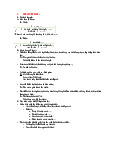

Preview text:
02:38 9/8/24 Lesson Plan
Business/Materials: Passage titled The History of Chocolate
https://www.esolcourses.com/content/reading/intermediate/graded-readers/the-history-of- chocolate.html Lesson Objectives
1. Consolidate knowledge about the Simple past tense.
2. Know more about Chocolate’s history.
Warm-up and Objective Discussion
1. Recalling information: What is the definition, structure, rules, and uses of the simple past tense?
2. Passage-related questions: Do you like to eat chocolate? Do you know what chocolate is made up?
Instruct and Model: The teacher read the passage aloud for the students. He/she can
also show pictures of cacao beans, chocolate-making processes, and the Maya and the Aztecs
people (as mentioned in the text) for the students to fully grasp the idea of the passage. Guided Practice
1. The students will make a list of new vocabulary/words they don’t understand. The teacher
will describe one by one until the students know the meaning of every word in the passage.
2. The teacher points out the grammatical structure relating to the simple past tense in the
passage. The students will then have to explain why they recognize it and why it is used in this context. Independent Practice 1. True or False:
- The chocolate isn’t popular nowadays.
- The cacao trees grow in Europe.
- The Maya made bread from cacao beans.
2. Read the story again and answer the questions.
- Where does chocolate come from?
- What is the most important ingredient in chocolate?
- Where did cacao beans originally grow?
- Who were the first people to eat cacao beans?
-Who introduced the cacao beans to the Aztecs?
- What did the Aztecs use the cacao beans for?
- What did the Maya give the Aztecs as tribute?
Assessment: The teacher grades the students’ answers and gives explanation. about:blank 1/2 02:38 9/8/24 Lesson Plan
1. What is the age of the students you are planning this listening passage for?
2. Describe your students' language proficiency.
3. List the title and speaker(s) or characters (if fiction) of the listening.
4. Discuss why you think this listening would be appropriate for your learners. Student profile: Age: 16
Language proficiency: B2 – Upper Intermediate
Audio title: The benefits of a bilingual brain – Mia Nacamulli
https://www.youtube.com/watch?v=MMmOLN5zBLY
I personally find TED-Ed an extremely interesting and helpful channel to improve my
students’ listening skills. It offers short video lessons on a variety of topics, so learners are
more likely to engage in what is being said. The average video length is just about 5 minutes
while the presenter’s voice is clear with standard pronunciation, vibrant intonation, and
appropriate speech rate. Those videos will be most suitable for intermediate-level learners as
they are able understand the content without too much difficulty regarding slang usage or
heavy accent. This particular audio ‘The benefits of a bilingual brain’ that I chose is hoped to
send some motivation to my ESL students by listing several advantages of speaking two or more languages. about:blank 2/2




